|
|
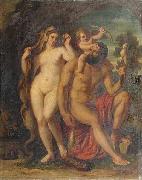 |
Carl Rahl
|
|
Carl Rahl, sometimes spelled Karl Rahl (13 August 1812 - 9 July 1865), was an Austrian painter.
Rahl was born in Vienna to Carl Heinrich Rahl (1779 - 1843), an engraver. He attended the Academy of Fine Arts Vienna and won a prize at the age of 19. From there he traveled to Munich, Stuttgart, Hungary, and in 1836 to Italy. He remained in Italy from 1836 to 1843, where he in particular studied representatives of the Venetian and Roman schools of art, and painted die Auffindung von Manfreds Leiche (1836).
Rahl's style, especially his views on color and perspective, were largely formed during his years in Rome. He returned after 1843 to Vienna for two years, and then led an itinerant life for the next five years, traveling through Holstein, Paris, Rome, Copenhagen, and Munich, making a living as a portrait painter. In this period he painted Manfreds Einzug in Luceria (1846), and die Christenverfolgung in den Katakomben.
In 1850, he was appointed professor at the Academy of Fine Arts Vienna, but for political reasons he was soon dismissed from the position. He then opened a private art school, which expanded quickly into a studio that produced monumental-scale paintings and enjoyed considerable success. He was commissioned by Greek philanthropist Simon Sinas to paint a number of works for the facade and vestibule of Vienna's Fleischmarkt Greek Church (Ludwig Thiersch being commissioned for the remainder of the frescoes), which was then being rebuilt by architect Theophil Freiherr von Hansen. In addition, Sinas commissioned four paintings depicting heroes of the Greek War of Independence, and a further four paintings to decorate his residence.
Rahl decorated the Heinrichshof in 1861 with personifications of Art, Friendship, and Culture, and the Palais Todesco with representations from the mythology of Paris. In 1864, he painted a number of allegorical figures in the stairway of the Waffenmuseum (now part of the Kunsthistorisches Museum). In this period he also painted several frescoes: Mädchen aus der Fremde (in a villa of Gmunden), a composition for a ballroom of a palace in Oldenburg, and a cycle from the tale of the Argonauts. Also, he painted the tympanum of the Athens Academy building, designed by Theophil von Hansen in 1859 and executed by Ernst Ziller (completed in 1885), and paintings in the portico of the Athens university, designed by Christian Hansen (Theophil Hansen's son). The central painting show Bavarian king Otto I surrounded by the Muses; the left hand fresco shows Prometheus bringing fire down from Mount Olympus. |
|
|
|
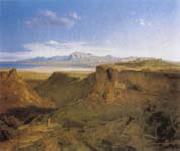 |
Carl Rottmann
|
|
German,1797-1850
was a German landscape painter and the most famous member of the Rottmann family of painters. Rottmann belonged to the circle of artists around the Ludwig I of Bavaria, who commissioned large landscape paintings exclusively from him. He is best known for mythical and heroising landscapes. The landscape painter Karl Lindemann-Frommel belonged to his school. Carl Anton Joseph Rottmann was born in Handschuhsheim (today a part of Heidelberg) on January 11, 1797. There he received his first drawing lessons from his father, Friedrich Rottmann, who taught drawing at the university in Heidelberg. In his first artistic period he painted atmospheric phenomena. In 1821 he moved to Munich, where his second period began, and in 1824 he married Friedericke, the daughter of his uncle, Friedrich Ludwig von Sckell, who served as an attendant at court. This connection cleared the way for an acquaintance with King Ludwig, who in 1826-27 sponsored his travels in Italy in order to widen his repertoire, which up to that point consisted solely of domestic, German, landscapes. Upon his return he received from King Ludwig I a commission for a monumental cycle of Italian landscapes in the arcade of the Munich Hofgarten. The cycle, completed in 1833 in fresco, gave visual expression to Ludwiges alliance with Italy, and raised the genre of landscape painting to the height of history painting, the preferred mode of the Kinges other great commissions for monumental painting. |
|
|
|
|
|
|
|
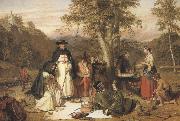 |
Charles landseer,R.A.
|
|
1799-1879
Painter, brother of Thomas Landseer. He trained initially with his father John Landseer, then under Benjamin Robert Haydon, and in 1816 he attended the Royal Academy Schools in London. In 1823 he accompanied Sir Charles Stuart de Rothesay (1779-1845) aboard HMS Wellesley on a voyage to Portugal and then to Brazil, in order to negotiate a commercial treaty with Pedro I, Emperor of Brazil (reg 1822-31). Many of the drawings he made on this trip were exhibited in 1828 at the British Institution, and in that year he sent his first painting to the Royal Academy. This was Dorothea, illustrating a scene from Cervantes's Don Quixote. He continued to exhibit at the Academy until his death, showing mostly romanticized history paintings or such literary subjects as Clarissa Harlowe in the Sponging House from Samuel Richardson's novel Clarissa (London, 1748). The English Civil War (1642-51) was of particular interest to him, his devotion to such historical subjects perhaps being attributable to the influence of his years with Haydon. He also painted portraits, genre scenes and animal studies . In 1837 he was elected ARA and in 1845 RA. In 1851, probably due to the influence of his brother Edwin, he succeeded George Jones as Keeper of the Royal Academy Schools. Responsible for instructing the antique class, his tenure was criticized both for the way his position had been obtained and for the deficiency of his teaching, and he retired from the Keepership in 1873 on full salary. |
|
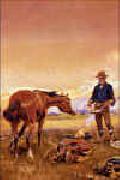 |
Charles M Russell
|
|
American Painter, 1864-1926
American painter and sculptor. In 1880 he left his upper-class home in St Louis for Montana Territory. He worked briefly on a sheep ranch, spent two years as a hunter's and trapper's assistant and then became a cowboy. During his considerable spare daytime hours he painted, sketched and modelled small animal figures in clay (e.g. Antelope, 1915; Fort Worth, TX, Amon Carter Mus.). Although he painted a few exceptional oils and watercolours prior to 1900, the vast majority of his best work was done in the last two decades of his life. Typically the subject-matter centres around cowboy life (e.g. Wagon Boss, 1909; Tulsa, OK, Gilcrease Inst. Amer. Hist. & A.) and the Plains Indians, for whom he had great respect. The luminous Piegans (1918; Denver, CO, Mus. W. A.), with its depiction of the Plains Indians, is a reminder of the vastness of the American West. Russell's sense of humour and empathy for his subject-matter radiates from his paintings as pleasingly as do the clear colours of the high country. His bronze sculptures (e.g. Buffalo Hunt, 1905; Denver, CO, Mus. W. A.) depict the same dramatic and tension-packed themes as his paintings. |
|
|
|
|
|
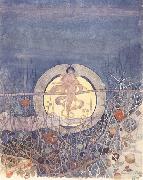 |
Charles Rennie Macintosh
|
|
Scottish Art Nouveau Designer , (1868-1928).
Scottish architect, designer and painter. In the pantheon of heroes of the Modern Movement, he has been elevated to a cult figure, such that the importance of his late 19th-century background and training in Glasgow are often overlooked. He studied during a period of great artistic activity in the city that produced the distinctive GLASGOW STYLE. As a follower of A. W. N. Pugin and John Ruskin, he believed in the superiority of Gothic over Classical architecture and by implication that moral integrity in architecture could be achieved only through revealed construction. Although Mackintosh's buildings refrain from overt classicism, they reflect its inherent discipline. His profound originality was evident by 1895, when he began the designs for the Glasgow School of Art. His decorative schemes, particularly the furniture, also formed an essential element in his buildings. During Mackintosh's lifetime his influence was chiefly felt in Austria, in the work of such painters as Gustav Klimt and such architects as Josef Hoffmann and Joseph Maria Olbrich. The revival of interest in his work was initiated by the publication of monographs by Pevsner (1950) and Howarth (1952). The Charles Rennie Mackintosh Society was formed in Glasgow in 1973; it publishes a biannual newsletter, has a reference library and organizes exhibitions. The Hunterian Art Gallery, University of Glasgow, which opened in 1981, |
|
 |
Charles Rennie Mackintosh
|
|
Scottish Art Nouveau Designer, 1868-1928
Scottish architect, designer and painter. In the pantheon of heroes of the Modern Movement, he has been elevated to a cult figure, such that the importance of his late 19th-century background and training in Glasgow are often overlooked. He studied during a period of great artistic activity in the city that produced the distinctive GLASGOW STYLE. As a follower of A. W. N. Pugin and John Ruskin, he believed in the superiority of Gothic over Classical architecture and by implication that moral integrity in architecture could be achieved only through revealed construction. Although Mackintosh's buildings refrain from overt classicism, they reflect its inherent discipline. His profound originality was evident by 1895, when he began the designs for the Glasgow School of Art. His decorative schemes, particularly the furniture, also formed an essential element in his buildings. During Mackintosh's lifetime his influence was chiefly felt in Austria, in the work of such painters as Gustav Klimt and such architects as Josef Hoffmann and Joseph Maria Olbrich. The revival of interest in his work was initiated by the publication of monographs by Pevsner (1950) and Howarth (1952). The Charles Rennie Mackintosh Society was formed in Glasgow in 1973; it publishes a biannual newsletter, has a reference library and organizes exhibitions. |
|
 |
Charles Ricketts
|
|
1866-1931
English painter, designer, writer and collector. He trained as an illustrator at the City and Guilds Technical Art School, Lambeth, London, where he met and formed a lifelong relationship with CHARLES HAZELWOOD SHANNON. He identified with the ideals of the Aesthetic Movement, finding inspiration in Renaissance art as well as in the French artists Gustave Moreau and Pierre Puvis de Chavannes. In 1888 he took over James Abbott McNeill Whistler's house, The Vale, in Chelsea and drew together an artists' colony. Inspired by the work of A. H. Mackmurdo and William Morris, he set up a small press over which he exercised complete control of design and production, producing art journals and books that included Oscar Wilde's A House of Pomegranates (1891) and The Sphinx (1894). Ricketts later designed founts, initials, borders and illustrations for the Vale Press (1896-1904), blending medieval, Renaissance and contemporary imagery. |
|
 |
Charles Robert Leslie
|
|
1794 - 1859
was born in London on 19 October 1794. His parents were American, and when he was five years of age he returned with them to their native country. They settled in Philadelphia, where their son was educated and afterwards apprenticed to a bookseller. He was, however, mainly interested in painting and the drama, and when George Frederick Cooke visited the city he executed a portrait of the actor from recollection of him on the stage, which was considered a work of such promise that a fund was raised to enable the young artist to study in Europe. He left for London in 1811, bearing introductions which procured for him the friendship of West, Beechey, Allston, Coleridge and Washington Irving, and was admitted as a student of the Royal Academy, where he carried off two silver medals. At first, influenced by West and Fuseli, he essayed high art, and his earliest important subject depicted Saul and the Witch of Endor; but he soon discovered his true aptitude and became a painter of cabinet-pictures, dealing, not like those of David Wilkie, with the contemporary life that surrounded him, but with scenes from the great masters of fiction, from Shakespeare and Cervantes, Addison and Moli??re, Swift, Sterne, Fielding and Smollett. Of individual paintings we may specify Sir Roger de Coverley going to Church (1819); May-day in the Time of Queen Elizabeth (1821); Sancho Panza and the Duchess (1824); Uncle Toby and the Widow Wadman (1831); La Malade Imaginaire, act iii. sc. 6 (1843); and the Dukes Chaplain Enraged leaving the Table, from Don Quixote (1849). Many of his more important subjects exist in varying replicas. He possessed a sympathetic imagination, which enabled him to enter freely into the spirit of the author whom he illustrated, a delicate perception for female beauty, an unfailing eye for character and its outward manifestation in face and figure, and a genial and sunny sense of humour, guided by an instinctive refinement which prevented it from overstepping the bounds of good taste. In 1821 Leslie was elected A.R.A., and five years later full academician. In 1833 he left for America to become teacher of drawing in the military academy at West Point, but the post proved an irksome one, and in some six months he returned to England. |
|
|
|
 |
Charles Roscoe Savage
|
|
1832-1909, He was a British-born landscape and portrait photographer who produced images of the American West. He is best known for his 1869 photographs of the linking of the first transcontinental railroad. Savage was born in Southampton, England, on August 16, 1832. At age 14, he joined The Church of Jesus Christ of Latter-day Saints (LDS Church). After serving missions for the church in Switzerland and England, he emigrated to the United States during the winter of 1855?C56. He initially found work as a photographer in New York City, and headed west the following year. He first settled in Nebraska, then Council Bluffs, Iowa, where he established his first independent studio and gallery. In the spring of 1860, he traveled to Salt Lake City, Utah Territory with his family, where he established a photography studio with a partner, Marsena Cannon, an early Utah daguerreotypist and photographer. A year later, after Cannon moved to southern Utah, Savage established a partnership with artist George Ottinger. Many of Savage's photographs were reproduced in Harper's Weekly newspaper, which created a national reputation for the firm. This partnership continued until 1870. As a photographer under contract with the Union Pacific Railroad, Savage traveled to California in 1866 and then followed the rails back to Utah. He photographed the linking of the Union Pacific and Central Pacific on Promontory Summit, at Promontory, Utah in 1869 |
|
|
|
|
|
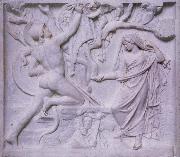 |
Christian Daniel Rauch
|
|
1777 Arolsen-1857 Dresden,was a German sculptor. Rauch was born at Arolsen in the Principality of Waldeck. His parents were poor and unable to place him under efficient masters. His first instructor taught him little else than the art of sculpting gravestones, and Professor Ruhl of Kassel could not give him much more. A wider field of improvement opened up before him when he removed to Berlin in 1797; but he was obliged to earn a livelihood by becoming a royal lackey, and to practise his art in spare hours. Queen Louisa of Prussia, surprising him one day in the act of modeling her features in wax, sent him to study at the Academy of Art. Not long afterwards, in 1804, Count Sandrecky gave Rauch the means to complete his education at Rome, where Wilhelm von Humboldt, Antonio Canova and Bertel Thorvaldsen befriended him. Among other works, he executed bas-reliefs of "Hippolytus and Phaedra," "Mars and Venus wounded by Diomede," and a "Child praying." In 1811 Rauch was commissioned to execute a monument for Queen Louisa of Prussia. |
|
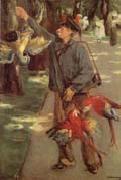 |
Christian Rohlfs
|
|
German Painter, 1849-1938
German painter and printmaker. He studied painting at the Kunstschule in Weimar (1870). Prolonged illness forced him to interrupt his studies, which he resumed in 1874 under Ferdinand Schauss (1832-1916) and Alexandre Struys (1852-1941). Through visits to Paris in the 1870s, he came into contact with the art of the Barbizon school, painting en plein-air on his return to Weimar. Under the influence of Struys he painted figurative works, such as Roman Builders (1879; Menster, Westfel. Landesmus.), and nudes in the tradition of academically enlightened Realism. In 1881 Rohlfs worked in a studio under Max Thedy (1858-1924). From c. 1883 he painted mainly landscapes with the approval of Ludwig von Gleichen-Russwurm (1836-1901), who was studying with Theodor Hagen (1842-1919), and was influenced in an indirect way by Albert Brendel (1827-95), who had taught at Weimar from 1875. He often chose formats that were unusually large for landscape paintings in this period, presenting landscape in a similar way to history painting. Atmosphere and light played an important role even in these early pictures, for example Sawmill at Ehringsdorf on the Ilm (930x780 mm, 1883; Weimar, Schlossmus.). From 1884 he worked as an independent painter. After 1885 colour became increasingly important for its own sake; light and shade were suggested purely by colour, which was applied in impasto spots and brushstrokes to create chiaroscuro values that determined the form, for example Wild Garden near Weimar (1888; Weimar, Schlossmus.). By the end of the 1880s he had developed an independent style parallel to Impressionist painting. When he saw works by Monet exhibited in Weimar in 1897, these corroborated his own efforts. |
|
|
|
|
|
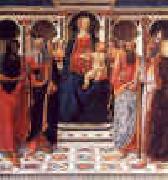 |
Cosimo Rosselli
|
|
Italian
1439-1507
Cosimo Rosselli Gallery
Born in Florence, at the age of fourteen he became a pupil of Neri di Bicci, and in 1460 he worked as assistant to his cousin Bernardo di Stefano Rosselli. A first youthful work of Cosimo mentioned by Giorgio Vasari is the Assumption of the Virgin altarpiece in the third chapel on the left of the nave in Sant'Ambrogio in Florence. In the same church, on the wall of one of the chapels, is a fresco by Cosimo which Vasari praises highly, especially for a portrait of the young scholar Pico of Mirandola. The scene, a procession bearing a miracle-working chalice, is painted with vigor and less mannerism than most of this artist's work. A picture painted by Rosselli for the church of the Annunziata, with figures of SS. Barbara, Matthew and the Baptist, is in the Academy of Florence.
Rosselli also spent some time in Lucca, where he painted several altar-pieces for various churches. A picture attributed to him, taken from the church of St. Girolamo at Fiesole, is now in the National Gallery of London. It is a large retable, with, in the center, St. Jerome in the wilderness kneeling before a crucifix, and at the sides standing figures of St. Damasus and St. Eusebius, St. Paula and St. Eustochium; below is a predella with small subjects. Though dry and hard in treatment, the figures are designed with much dignity.
The Berlin Gallery possesses three pictures by Rosselli: The Virgin in Glory, The Entombment of Christ, and The Massacre of the Innocents. In 1480 Rosselli, together with the chief painters of Florence, was invited by Pope Sixtus IV to Rome to assist in the painting of the frescoes in the Sistine Chapel. Three of these were executed by him The Destruction of Pharaohs Army in the Red Sea, Christ Preaching by the Lake of Tiberias, and The Last Supper. Rosselli's Sistine frescoes were partly painted by his assistant and son in law Piero di Cosimo, who was so called after Cosimo Rosselli. His chief pupil was Fra Bartolomeo.
According to Vasari, Rosselli died in 1484, but this is a mistake, as his is known to be living on 25 November 1506 |
|
|
|
 |
Cristobal Rojas
|
|
Cristobal Rojas (Cua, Miranda, 15 December 1857 e Caracas, 8 November 1890) was one of the most important and high-profile Venezuelan painters of the 19th century. Rojas's styles varied considerably throughout his life, and he displayed talents in painting that ranged primarily for dramatic effect, to works done in the Impressionist style.
Cristebal Rojas Poleo was born in the city of Cea in the Valles del Tuy to parents who worked in the medical profession. Part of his childhood occurred during the middle of the federal war (1859 - 1863) and Cea was particularly affected by the events of the war. He initiated studies under his grandfather, Jose Luis Rojas, who taught him how to draw and motivated him to improve. At 13 years old, his father died and he was forced to begin work in a tobacco factory in Cea to help support his family. In 1878, an earthquake devastated the Valles del Tuy region, and the Rojas faced poverty. As a result he moved to Caracas where he continued his painting studies, despite again having to work in the tobacco industry to support his mother and family.
In Caracas he attended classes by Jose Manuel Mauco at the Universidad Central de Venezuela. Between 1880 and 1882, he developed a keen interest in oils and displayed a primitive technique that would prevail in his later paintings such as Ruinas de Cea despues del Terremoto and Ruinas del templo de la Merced. During this time he became acquainted with the painter Antonio Herrera Toro, also coming under contract as Toro's assistant to paint Caracas Cathedral.
|
|
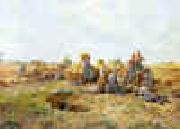 |
Daniel Ridgeway Knight
|
|
1839-1924
Daniel Ridgeway Knight Gallery
Daniel Ridgway Knight was born on March 15,1839 in Pennsylvania. He studied and exhibited at the Pennsylvania Academy of the Fine Arts, were he was a classmate of Mary Cassatt and Thomas Eakins. In 1861, he went to Paris to study at L'Ecole des Beaux-Arts under Cabanel, and to apprentice in the atelier of Charles-Gabriel-Gleyere. |
|
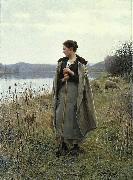 |
Daniel Ridgway Knight
|
|
(March 15, 1839 - March 9, 1924) was an American artist born at Philadelphia, Pennsylvania. He was a pupil at the Ecole des Beaux-Arts, Paris, under Gleyre, and later worked in the private studio of Meissonier. After 1872 he lived in France, having a house and studio at Poissy on the Seine.
Spring BlossomsHe painted peasant women out of doors with great popular success. He was awarded the silver medal and Cross of the Legion of Honor, Exposition Universelle, Paris, 1889, and was made a Knight of the Royal Order of St. Michael of Bavaria, Munich, 1893, and receiving the gold medal of honor from the Pennsylvania Academy of the Fine Arts, Philadelphia, 1893. His son, Louis Aston Knight (1873 - 1948), is also known as a landscape painter.
|
|
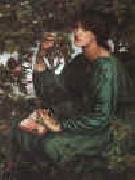 |
Dante Gabriel Rossetti
|
|
English Pre-Raphaelite Painter, 1828-1882
Rossetti's first major paintings display some of the realist qualities of the early Pre-Raphaelite movement. His Girlhood of Mary, Virgin and Ecce Ancilla Domini both portray Mary as an emaciated and repressed teenage girl. His incomplete picture Found was his only major modern-life subject. It depicted a prostitute, lifted up from the street by a country-drover who recognises his old sweetheart. However, Rossetti increasingly preferred symbolic and mythological images to realistic ones. This was also true of his later poetry. Many of the ladies he portrayed have the image of idealized Botticelli's Venus, who was supposed to portray Simonetta Vespucci.
Although he won support from the John Ruskin, criticism of his clubs caused him to withdraw from public exhibitions and turn to waterhum, which could be sold privately.
In 1861, Rossetti published The Early Italian Poets, a set of English translations of Italian poetry including Dante Alighieri's La Vita Nuova. These, and Sir Thomas Malory's Morte d'Arthur, inspired his art in the 1850s. His visions of Arthurian romance and medieval design also inspired his new friends of this time, William Morris and Edward Burne-Jones. Rossetti also typically wrote sonnets for his pictures, such as "Astarte Syraica". As a designer, he worked with William Morris to produce images for stained glass and other decorative devices.
Both these developments were precipitated by events in his private life, in particular by the death of his wife Elizabeth Siddal. She had taken an overdose of laudanum shortly after giving birth to a stillborn child. Rossetti became increasingly depressed, and buried the bulk of his unpublished poems in his wife's grave at Highgate Cemetery, though he would later have them exhumed. He idealised her image as Dante's Beatrice in a number of paintings, such as Beata Beatrix.
These paintings were to be a major influence on the development of the European Symbolist movement. In these works, Rossetti's depiction of women became almost obsessively stylised. He tended to portray his new lover Fanny Cornforth as the epitome of physical eroticism, whilst another of his mistresses Jane Burden, the wife of his business partner William Morris, was glamorised as an ethereal goddess. |
|
|
|
|
|
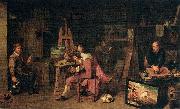 |
David Rijckaert
|
|
David Ryckaert III, sometimes called The Younger (2 December 1612 (baptised) - 11 November 1661) was a Flemish painter.
A member of the Ryckaert family of artists, he was born and raised in Antwerp, the city in which he conducted his career and in which he died. He was the son of David Ryckaert II, grandson of David Ryckaert I, and nephew of Martin Ryckaert.
David Ryckaert was a pupil of his homonymous father; his work was influenced by the styles of Adriaen Brouwer and both David Teniers the Elder and David Teniers the Younger. Ryckaert is noted for large and often humorous genre pictures of farmers and landlords, and powerfully coloured still lifes. He also painted a range of other subjects, including religious pictures; his The Temptation of Saint Anthony (1650) is in the collection of the Palazzo Pitti in Florence.
|
|
|
|
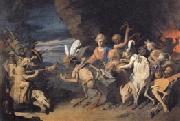 |
David Ryckaert
|
|
Flemish Baroque Era Painter, 1612-1661
was a Flemish painter. A member of the Ryckaert family of artists, he was born and raised in Antwerp, the city in which he conducted his career and in which he died. He was the son of David Ryckaert II, grandson of David Ryckaert I, and nephew of Martin Ryckaert. David Ryckaert was a pupil of his homonymous father; his work was influenced by the styles of Adriaen Brouwer and both David Teniers the Elder and David Teniers the Younger. Ryckaert is noted for large and often humorous genre pictures of farmers and landlords, and powerfully coloured still lifes. He also painted a range of other subjects, including religious pictures; his The Temptation of Saint Anthony (1650) is in the collection of the Palazzo Pitti in Florence. |
|
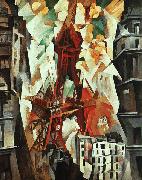 |
Delaunay, Robert
|
|
French Cubist Painter, 1885-1941
French painter, printmaker and writer. Taking Cubism as one of his points of departure, he first developed a vocabulary of colour planes only distantly dependent on observed motifs, and by the 1930s he had arrived at a purely self-sufficient language of geometric forms. He remained active as a theoretician until the end of his life, |
|
 |
Diego Rivera
|
|
Mexican Social Realist Muralist, 1886-1957,Mexican muralist. After study in Mexico City and Spain, he settled in Paris from 1909 to 1919. He briefly espoused Cubism but abandoned it c. 1917 for a visual language of simplified forms and bold areas of colour. He returned to Mexico in 1921, seeking to create a new national art on revolutionary themes in the wake of the Mexican Revolution. He painted many public murals, the most ambitious of which is in the National Palace (1929 ?C 57). From 1930 to 1934 he worked in the U.S. His mural for New York's Rockefeller Center aroused a storm of controversy and was ultimately destroyed because it contained the figure of Vladimir Ilich Lenin; he later reproduced it at the Palace of Fine Arts in Mexico City. With Jose Clemente Orozco and David Alfaro Siqueiros, Rivera created a revival of fresco painting that became Mexico's most significant contribution to 20th-century art. His large-scale didactic murals contain scenes of Mexican history, culture, and industry, with Indians, peasants, conquistadores, and factory workers drawn as simplified figures in crowded, shallow spaces. Rivera was twice married to Frida Kahlo. |
|
|
|
 |
Dufy Raoul
|
|
Le Havre 1877-Forcalquier 1953
was a French Fauvist painter. He developed a colourful, decorative style that became fashionable for designs for ceramics, textiles and decorative schemes for public buildings. He is noted for scenes of open-air social events. Raoul Dufy was born at Le Havre, in Normandy, one of a family of nine members. He left school at the age of 14 to work in a coffee importing company. In 1895 when he was 18, he started evening classes in art at Le Havre Ecole des Beaux-Arts. He and Othon Friesz, a school friend, studied the works of Eug??ne Boudin in the museum in Le Havre. Raoul Dufy, Regatta at Cowes, (1934), Washington D.C. National Gallery of Art.In 1900, after a year of military service, Raoul won a scholarship enabling him to attend the Ecole Nationale des Beaux-Arts in Paris, where he was a fellow student with Georges Braque. The impressionist landscapists, such as Claude Monet and Camille Pissarro, influenced him. Introduced to Berthe Weill in 1902, she showed his work in her gallery. Henri Matisse's Luxe, Calme et Volupte, which Dufy saw at the Salon des Independants in 1905, was a revelation to the young artist and directed his interest towards Fauvism. Les Fauves (wild beasts) emphasised bright colour and rich bold contours in their work, and Dufy's painting reflects this approach until about 1909, when contact with the work of Paul Cezanne led him to adopt a somewhat subtler technique. |
|
|
|
|
|
|
|
|
|
|
|
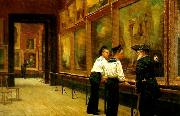 |
edward r taylor
|
|
Edward Richard Taylor RBSA (June 14, 1838 - January 11, 1911) was an English artist and educator. He painted in both oils and watercolours.
Taylor taught at the Lincoln School of Art and became influential in the Arts and Crafts movement as the first headmaster at the Birmingham Municipal School of Arts and Crafts from 1877-1903.
In December 1898, he founded Ruskin Pottery at Smethwick, Staffordshire. His son William Howson Taylor (1876 -1935) took over Ruskin Pottery after the death of his father. |
|
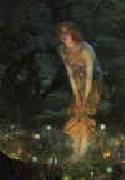 |
Edward Robert Hughes
|
|
British
1851-1917
Edward Robert Hughes (1851-1917) is a well known English painter who worked in a style influenced by Pre-Raphaelitism and Aestheticism. Some of his best known works are Midsummer Eve and Night With Her Train of Stars. Hughes was the nephew of Arthur Hughes. He often used watercolour/gouache. He was elected ARWS in 1891 and chose as his diploma work for election to full membership a mystical piece inspired by a verse by Christina Rossetti's "Amor Mundi". Technically Hughes experimented with ambitious techniques. He was a perfectionist who did numerous studies which in their own right turned out to be good enough for exhibition
He was also an assistant to the elderly William Holman Hunt. He helped the increasingly infirm Hunt with the version of The Light of the World now in St. Paul's Cathedral and with The Lady of Shalott. He died on April 23 1914 at his cottage in St. Albans, Hertfordshire.
|
|
|
|
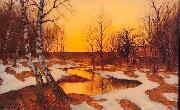 |
Edward Rosenberg
|
|
painted Solnedgang i vinterlandskap in 1921
Edward Rosenberg (1858-1934)Aliases: Axel Edvard John Rosenberg; Axel Edward John Rosenberg; Edvard RosenbergProfessions: Landscape painter. |
|
|
|
|
|
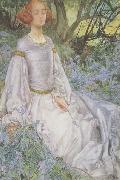 |
Eleanor Fortescue-Brickdale,RWS
|
|
1872-1945
English illustrator, painter and designer. She entered the Royal Academy Schools, London, and won a prize for a mural design in 1897. She specialized in book illustration, in pen and ink and later in colour. Among her many commissions were illustrations to Tennyson's Poems (1905) and Idylls of the King (1911) and Browning's Pippa Passes (1908). She was particularly popular with the publishers of the lavishly illustrated gift-books fashionable in the Edwardian era. She exhibited regularly at the Royal Academy and the Royal Water-Colour Society. She took up stained-glass design (windows in Bristol Cathedral), which modified her style of illustration to flat areas of colour within black outlines. |
|
|
|
|

